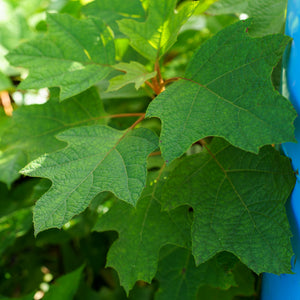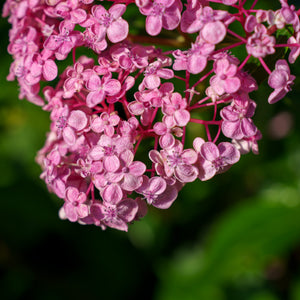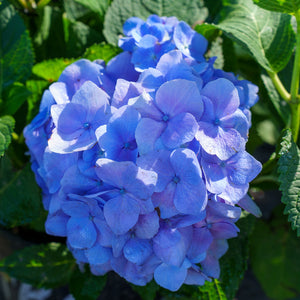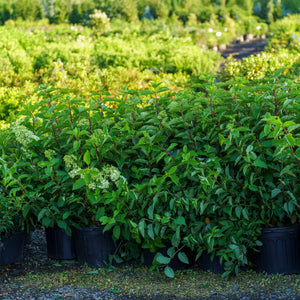The Hydrangea Guide
Hydrangeas grace the garden with their lush blooms and diverse forms, offering a timeless and enchanting presence in any landscape. With their captivating clusters of flowers and versatile growth habits, hydrangeas captivate attention and add a touch of elegance to gardens and outdoor spaces. These exquisite flowering shrubs are celebrated for their adaptability, thriving in various climates with the right care. Whether you envision a vibrant cottage garden, a formal landscape, or a charming woodland retreat, hydrangeas stand as an excellent choice, ready to infuse your outdoor haven with beauty and allure.
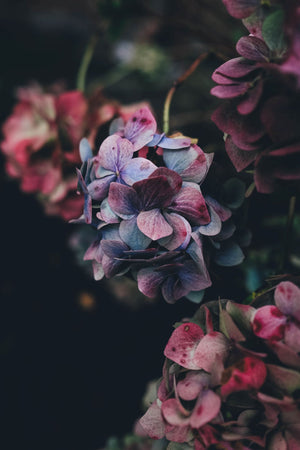
About
Hydrangeas, members of the Hydrangeaceae family, stand as enchanting and versatile additions to landscapes, captivating garden enthusiasts with their stunning blooms and varied growth habits. Comprising a diverse array of deciduous and evergreen shrubs, hydrangeas are cherished for their captivating presence and ecological significance. With well over 70 recognized species, hydrangeas thrive in temperate and subtropical regions, weaving their floral tapestry into the landscapes they inhabit. These charming shrubs are recognized for their large, showy flower clusters that span a spectrum of colors, ranging from pristine whites and soft pinks to vibrant blues and deep purples, creating a visual symphony throughout the growing season.
One of the distinctive features of hydrangeas is their ability to adapt gracefully to changing seasons, adding year-round interest to gardens. Their lush green leaves, often tinged with autumnal hues, evolve with the shifting seasons, introducing dynamic colors to outdoor spaces. As fall approaches, certain varieties undergo a spectacular transformation, unveiling warm tones of yellow, orange, and copper, providing a grand finale to the growing season.
Beyond their visual appeal, hydrangeas play a crucial role in supporting local ecosystems. Valued for their nectar-rich flowers, these shrubs act as magnets for pollinators, attracting bees, butterflies, and hummingbirds. The dense foliage and intricate branching structure also offer shelter for small birds and insects, contributing significantly to the overall biodiversity of the garden.
Hydrangeas showcase remarkable adaptability to various soil types and environmental conditions. While they prefer moist, well-drained soil, they demonstrate resilience in both full sun and partial shade, making them versatile choices for different garden settings. Their moderate growth rate and manageable size render them suitable for a range of landscaping applications, from hedging and borders to standalone features.
Popular species within the hydrangea genus include the classic Bigleaf Hydrangea (Hydrangea macrophylla) and the delicate Lacecap Hydrangea (Hydrangea serrata), each bringing its unique characteristics to the forefront. Whether employed as a striking focal point in a garden, planted in groups to create a natural hedge, or integrated into mixed borders, hydrangeas infuse an air of elegance and beauty into any landscape.
By selecting and caring for hydrangeas in your outdoor space, you not only enhance the aesthetic appeal but also actively contribute to the preservation of these remarkable shrubs and the biodiversity they support. Embrace the diversity and resilience of hydrangeas, and let your garden harmonize with the ever-changing rhythms of nature.
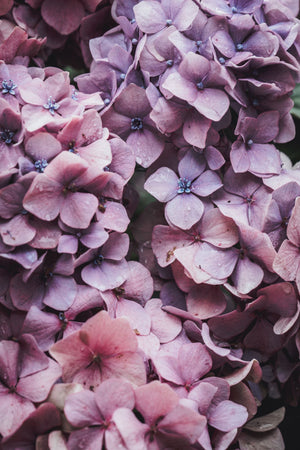
Planting
Hydrangeas, with their captivating blooms and versatile nature, demand careful consideration during the planting process to ensure their successful establishment and flourishing growth. Here are essential guidelines for planting and caring for hydrangeas:
Soil: Hydrangeas thrive in well-draining soil that is rich in organic matter. They prefer slightly acidic soil with a pH between 5.5 and 6.5. To create an optimal planting environment, prepare the site by loosening the soil and incorporating generous amounts of compost or well-rotted manure. This not only enhances drainage but also fosters fertility, providing a nutrient-rich foundation for the hydrangea.
Sunlight: Hydrangea plants have varying sunlight preferences based on the species. While some thrive in full sun, others prefer partial shade. When selecting a planting location, consider the specific needs of your hydrangea variety. Generally, hydrangeas benefit from morning sun and afternoon shade, especially in regions with hot and dry climates. Adequate sunlight ensures optimal blooming and overall plant health.
Watering: Adequate and consistent watering is crucial, especially during the initial stages of hydrangea establishment. Deeply water the plant immediately after planting, and continue with regular irrigation throughout the first year. Adjust the watering frequency, aiming for deep and thorough watering once or twice a week, depending on rainfall and soil moisture levels. It is essential to avoid overwatering, as excess moisture can lead to root rot.
Mulching: Applying a layer of organic mulch around the base of the hydrangea offers multiple benefits. Mulch helps conserve soil moisture, suppresses weed growth, and regulates soil temperature. Utilize materials such as wood chips, bark, or compost as mulch. Maintain a gap of a few inches between the mulch and the trunk to prevent excess moisture accumulation around the plant's base.
Pruning: Hydrangeas generally require minimal pruning, with specific approaches based on the hydrangea type. Focus on removing any dead, damaged, or crossing branches. The ideal time for pruning varies between hydrangea varieties but is often during late winter or early spring when the plant is dormant, just before new growth emerges. This ensures minimal stress on the hydrangea and promotes healthy development.
By adhering to these fundamental planting and care guidelines, you can facilitate the successful establishment and robust growth of your hydrangea plants. These practices will contribute to the longevity and beauty of your landscape, allowing the hydrangeas to thrive and grace your outdoor space with their exquisite blooms for years to come.
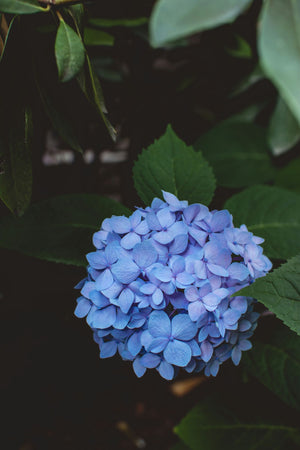
Care
Hydrangeas, with their enchanting allure and diverse varieties, demand specific care practices to ensure their optimal growth and the longevity of their exquisite blooms. Here are comprehensive guidelines for the care of hydrangeas, ensuring they grace your garden with enduring beauty:
Watering: Provide consistent and moderate watering during the growing season for your hydrangeas. Aim for approximately one inch of water per week, adjusting based on natural rainfall. It is crucial to water deeply and thoroughly, encouraging robust root development. Shallow watering should be avoided to prevent stress and dehydration. In periods of drought or elevated temperatures, additional watering may be necessary to maintain adequate soil moisture.
Pruning: Hydrangeas generally require careful pruning to enhance their overall health and aesthetic appeal. Remove any dead or damaged branches to preserve the plant's vitality and appearance. Depending on the hydrangea type, pruning approaches may vary. For most varieties, pruning is best done during late winter or early spring, before the onset of new growth. Employ clean, sharp pruning tools to minimize the risk of harm to the plant. Deadheading spent flowers can stimulate new growth and potentially trigger a second blooming, contributing to a prolonged flowering season.
Fertilizing: Fertilization plays a crucial role in promoting vibrant growth and abundant flowering in hydrangeas. Apply a balanced, slow-release fertilizer in the spring or early summer, adhering to the recommended application rates and timing specified by the manufacturer. Exercise caution to avoid over-fertilizing, as it can negatively impact the plant's root system. When uncertain, opt for a conservative approach and use less fertilizer, ensuring the health and longevity of your hydrangeas.
Soil and Sunlight: Hydrangeas thrive in well-drained, moist soil and often prefer partial shade, especially in regions with hot climates. While they exhibit tolerance to diverse soil types, ensuring optimal drainage is essential for their well-being. Mulching around the base of the plant contributes to moisture retention and regulates soil temperature, creating a conducive environment for healthy growth.
Pests and Diseases: Though generally resilient, hydrangeas can face challenges from pests like aphids, spider mites, and diseases like powdery mildew. Vigilance is key—regularly inspect your plants for signs of damage or disease. Swift action with appropriate insecticides or fungicides, when necessary, will help safeguard the health and vitality of your hydrangeas.
By adhering to these holistic care guidelines, your hydrangeas will flourish, becoming a perennial source of beauty, color, and majesty in your garden for many years to come.
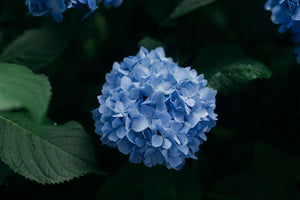
How To Use
Hydrangeas, with their graceful and versatile nature, offer a myriad of creative possibilities to elevate your landscape. Tailor their characteristics to your advantage with these insightful recommendations:
Statement Centerpiece: Create an exquisite focal point in your garden by showcasing hydrangeas as a stunning centerpiece. Plant a cluster of these captivating shrubs in an open area to highlight their diverse forms and enchanting blossoms. Experiment with different hydrangea varieties to craft a display that evolves beautifully throughout the seasons, ensuring a dynamic and ever-changing garden showcase.
Elegant Borders: Define the edges of your garden beds with the sophistication of hydrangeas. Their lush, compact growth makes them ideal for creating borders that bring a touch of refinement to your outdoor space. Allow these charming shrubs to weave a tapestry of color and texture along pathways or around other garden features, adding a sense of structured elegance to your landscape.
Vibrant Hedges: Transform practical features into eye-catching elements by planting hydrangeas as vibrant hedges. Their dense growth habit not only provides privacy but also introduces a burst of color to your surroundings. Regularly shape these living boundaries to maintain a neat appearance, allowing hydrangeas to redefine the aesthetics of your garden with their captivating blooms.
Container Magic: Unleash your creativity with container gardening by cultivating hydrangeas in pots or containers. This versatile approach allows you to move these delightful shrubs to different areas, adding bursts of color to patios, decks, or even balconies. Experiment with various container sizes and shapes to customize your outdoor space, creating a mobile masterpiece that adapts to your design preferences.
Companion Planting: Harness the beauty and functionality of hydrangeas by using them as companion plants. Their vibrant foliage and flowers complement a variety of other plants, making them a perfect addition to mixed borders or group plantings with perennials. This not only creates visually pleasing combinations but also fosters ecologically supportive plant communities, enhancing the overall biodiversity of your garden.
Whether you're seeking a striking focal point, defining borders, creating vibrant hedges, or experimenting with container gardening, hydrangeas bring elegance and adaptability to your landscape. Consider their varied blooms, lush foliage, and versatile nature when planning your garden, transforming it into a masterpiece that evolves with the seasons, adding a touch of sophistication to your outdoor haven.
Conclusion
In the realm of landscaping, hydrangeas stand out as versatile and captivating shrubs, offering a symphony of colors, forms, and practical uses for your outdoor sanctuary. With their graceful demeanor and adaptability, hydrangeas contribute a touch of refined beauty to various garden settings. As you craft the story of your garden, hydrangeas become integral characters, their ever-changing hues and intricate blossoms painting a living canvas that evolves gracefully with the seasons, ensuring your landscape remains a perpetual work of art.
Beyond their visual allure, hydrangeas play multifaceted roles in your outdoor haven. Whether employed as standalone focal points, elegant borders, vibrant hedges, or potted masterpieces, these shrubs seamlessly blend aesthetics with practicality. From crafting privacy to defining spaces and enhancing the overall charm of your garden, hydrangeas prove that beauty can indeed serve a purpose.
A testament to their versatility, hydrangeas make excellent companions to a variety of plants. Their ability to thrive in mixed borders or complement other perennials showcases their compatibility in diverse plant communities. With hydrangeas as part of your garden ensemble, you're not merely cultivating plants; you're nurturing a harmonious ecosystem that flourishes with vitality and beauty.
Embrace the ever-changing melody of your garden with hydrangeas as key players. Their resilience and ability to adapt ensure that your landscape remains dynamic, responding to the rhythm of the seasons. By incorporating hydrangeas, you're creating an outdoor space that resonates with life, color, and the subtle charm of nature.
In the realm of garden design, hydrangeas are not just shrubs; they are living notes in the melody of your landscape. With thoughtful planting, care, and creative deployment, these versatile shrubs can be the crescendo that elevates your outdoor space to a masterpiece. Nurture your garden with the dedication it deserves, and let hydrangeas be the timeless refrain that brings you joy for years to come.

